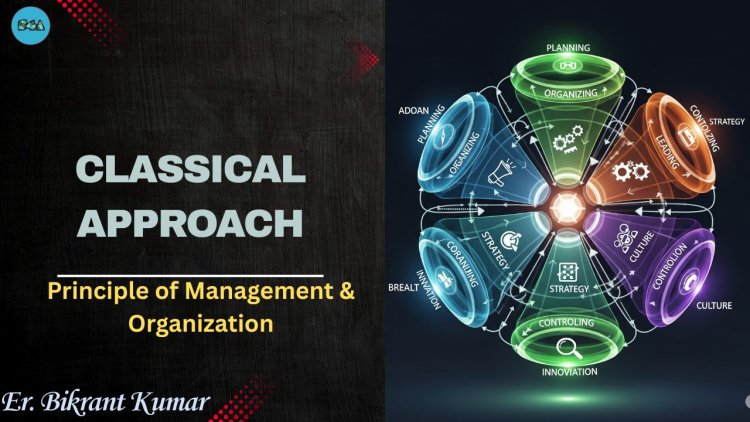Classical Approach
Evolution of Management Thought

Definition
The Classical Theory of Management is one of the earliest theories developed to understand how to effectively manage organizations. It emerged during the late 19th and early 20th centuries, primarily during the Industrial Revolution, when industries were growing, and there was a need for efficiency, discipline, and productivity in factories.
Main Objective:
To increase efficiency, productivity, and output through formal structure, clear tasks, and rational planning.
Duration (Time Period)
- Developed during the late 19th century to the early 20th century.
- Primarily between 1880 to 1930.
Main Contributors / Authors
|
Author |
Country |
Contribution |
|
Frederick Winslow Taylor |
USA |
Scientific Management |
|
Henri Fayol |
France |
Administrative Theory |
|
Max Weber |
Germany |
Bureaucratic Management |
Major Types of Classical Management Theory:
1. Scientific Management Theory
2. Administrative Management Theory
3. Bureaucratic Management Theory
1. Scientific Management Theory
- Author: Frederick Winslow Taylor
- From: United States
- Developed in: 1900s
Objective:
To improve worker productivity by using scientific methods to analyze and break down tasks.
Key Concepts:
- Time and motion studies
- Standardization of tools and tasks
- Scientific selection and training of workers
- Wage incentives (pay more for more work)
Principles (Taylor’s Four Principles):
- Science, not rule of thumb – Replace guesswork with science
- Scientific selection of the worker
- Training and development
- Close cooperation between workers and management
Advantages:
- Increased productivity
- Better performance from workers
- Clear guidelines and task division
Disadvantages:
- Treats workers like machines
- Ignores human and social needs
- Boring and repetitive work
Real-life Example:
In a car manufacturing plant, each worker is trained for one specific task (e.g., attaching tires). This increases speed and efficiency. Like Ford's Assembly Line.
2. Administrative Management Theory
- Author: Henri Fayol
- From: France
- Developed in: Early 1900s
Objective:
Focus on the management process and managerial functions in an organization.
Key Concepts:
Fayol proposed that management is a universal process made of five primary functions:
- Planning
- Organizing
- Commanding
- Coordinating
- Controlling
Fayol’s 14 Principles of Management:
- Division of Work
- Authority and Responsibility
- Discipline
- Unity of Command
- Unity of Direction
- Subordination of Individual Interest
- Remuneration
- Centralization
- Scalar Chain (line of authority)
- Order
- Equity
- Stability of tenure
- Initiative
- Esprit de Corps (team spirit)
Advantages:
- Structured organization
- Clear leadership roles
- Universal principles useful for many organizations
Disadvantages:
- Rigid and formal
- Less focus on employee motivation
- Ignores external environment
Real-life Example:
In a school, there is a Principal (Commanding), staff meetings (Coordinating), lesson plans (Planning), rules for students and teachers (Discipline) – following Fayol’s principles.
3. Bureaucratic Management Theory
- Author: Max Weber
- From: Germany
- Developed in: Early 1900s
Objective:
To create an ideal organization through clear hierarchy, rules, and roles.
Key Concepts:
- Clear hierarchy of authority
- Formal rules and regulations
- Impersonality (treat everyone equally)
- Merit-based employment (promotion based on qualification)
- Division of labor
Advantages:
- Fair and equal treatment
- No favoritism
- Efficient and predictable system
Disadvantages:
- Too much paperwork
- Delays in decision-making
- Rigid and inflexible
Real-life Example:
Government departments like Passport Office or Railway Department follow bureaucratic structure – rules, forms, approvals, chain of command.
Concept of Classical Theory (in Simple Words):
The Classical Theory believes that organizations work best when:
- There is order and discipline
- Tasks are well planned
- Every employee knows what to do
- Managers are strict but fair
- Focus is more on efficiency and output, not emotions
Benefits of Classical Management Theory:
- Clear roles and responsibilities
- Focus on productivity and efficiency
- Strong managerial control
- Easy to train new employees
Limitations:
- Ignores human emotions and teamwork
- No room for creativity or flexibility
- Treats humans like machines
- Not suitable for modern, dynamic work environments
Comparison Table:
|
Type |
Author |
Origin |
Focus Area |
Example |
|
Scientific Management |
Frederick W. Taylor |
USA |
Task efficiency |
Ford Assembly Line |
|
Administrative Management |
Henri Fayol |
France |
Management process |
School Administration |
|
Bureaucratic Management |
Max Weber |
Germany |
Rules and hierarchy |
Passport Office, Govt. Dept. |
Real-Life Combined Example:
Imagine a hospital:
- The scientific theory is used in the operation theatre – procedures are standardized.
- Administrative theory helps the hospital management plan and coordinate departments.
- Bureaucratic theory governs the HR and legal procedures – rules for hiring, complaints, etc.
-----------------------------
Files
What's Your Reaction?















